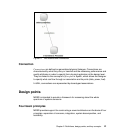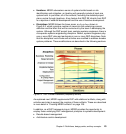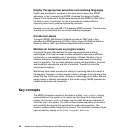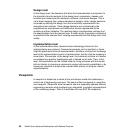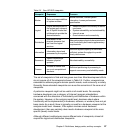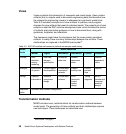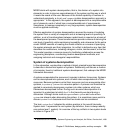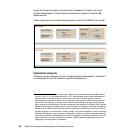
Chapter 2. Definitions, design points, and key concepts 29
MDSD starts with system decomposition, that is, the division of a system into
elements in order to improve comprehension of the system and the way in which
it meets the needs of the user. Because of the limited capability of humans to
understand complexity, a
divide and conquer system decomposition approach is
appropriate.
7
In this approach, the system is decomposed into a comprehensible
set of elements, each of which has a comprehensible set of requirements.
Sometimes, to manage complexity in very large systems, system decomposition
must be applied recursively.
Effective application of system decomposition requires the means of modeling
the system from a variety of viewpoints and at increasing levels of specificity. In
addition, a set of transformations between model levels is required as a basis of
the development process. These transformations provide a means of deriving the
next level of specificity while maintaining traceability and coherence for the entire
model. MDSD consists of creating the model artifacts as a means of specifying
the system elements and their integration. An artifact is defined as any item that
describes the architecture, including a diagram, matrix, text document, or the like.
This model provides a common means for facilitating collaboration across the
engineering disciplines, coordinating iterative development methods, and
assigning technical and managerial responsibilities.
System of systems decomposition
In this subsection, we describe a method of object oriented logical decomposition
to describe a hierarchical system of systems. Additionally, we discuss a number
of principles, found in traditional systems development, that underpin the MDSD
framework discussed.
A system encapsulates the resources it requires to deliver its services. Systems
can be decomposed into systems, each of which also encapsulates all of their
resources. Because systems control their resources and can encapsulate other
systems, a
system of systems is a recursive pattern. A process can therefore be
applied to recursively decompose a system into other systems, which are
themselves decomposed further. During such recursive decomposition it is
important to understand at which
level in the hierarchy we stand during a
discussion. Although terms such as
superordinate system and subordinate
system
are relevant when discussing the pattern, it is sometimes more useful to
discuss
system levels because more than two levels can be considered.
The term
system level indicates the relative position in the overall hierarchy:
System level 1 represents the root system (by definition, there is always exactly
one system level 1 system). An overview of the key artifacts in two system levels
is shown in Figure 2-3.
7
B. Blanchard and W. Fabrycky, Systems Engineering and Analysis, 3rd Edition, Prentice Hall, 1998



